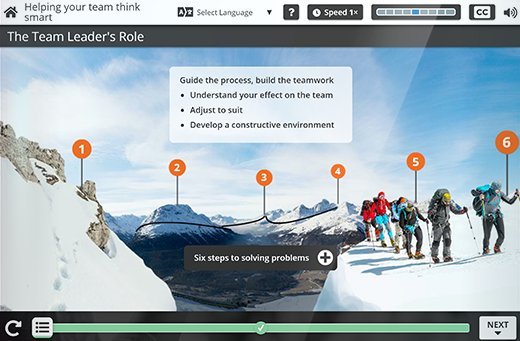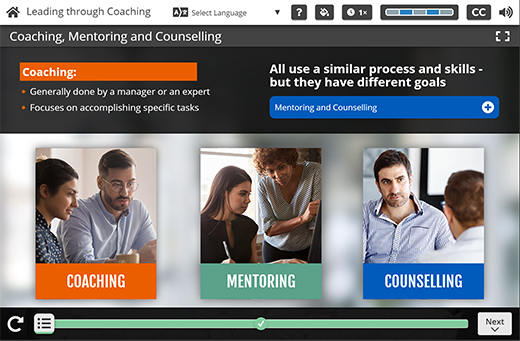15 search results for 'Learning Pathway'.
How can You Improve Employee Performance?
To improve employee performance you need to use strategies which encourage your employees to exceed expectations. Strategies include setting expectations, managing performance, communicating, motivating, providing feedback and solving problems. You can have the most highly skilled and trained workforce but without good management strategies they will struggle to reach their performance targets. Engaged and supported…
How Do You Evaluate Performance?
To effectively evaluate performance you must explore pro and cons of different evaluation strategies. You must find a strategy which allows you to evaluate performance fairly and accurately. A thorough evaluation is specific, has deadlines, is realistic, honest, thorough and evaluates performance, not personality. As a manager you must be equip to listen, handle difficult…
Managing Conflict – Identify a Difficult Employee
At some point, we will all encounter someone we find difficult to work with. Personality clashes, different working styles or opposing views are often the cause. But as a project manager, you will encounter challenging behaviour which can disrupt team dynamics and productivity and need to be tackled. Identifying a difficult employee in the workplace…
How do you Manage Conflict at Work?
Managing conflict at work involves addressing issues quickly and directly, handling them constructively and turning difficult situations into opportunities for learning, development and enhanced innovation and creativity. To achieve this you need to know how to identify causes and use appropriate conflict resolution strategies. All organisations will have conflict from time to time. Conflict is…
How do you Set Clear Performance Expectations?
Setting clear performance expectations involves creating processes which manage and monitor staff performance. These processes include performance expectations – focusing on results and goals to achieve; and behavioural expectations – focusing on expected values, behaviours and attitudes that are required in the role. The process of setting expectations can involve individual target setting, team plans,…
How Do You Set Performance Goals and Measures?
To set performance goals and measures you will need to create a shared primary goal. Working closely with your team the process should be collaborative. And it must incorporate your organisations overall strategy, the purpose of your department or project and individual objectives. As a result, the drive of the organisation, department and each employee…
How Can Team Dynamics Be Improved?
Team dynamics can be improved by focusing on certain strategies which will create trust and a share common purpose. An underlying factor in positive group dynamics is trust. A team without trust is not really a team. Team trust is the foundation which enables a group of individuals to work together. Without it people are…
What are the Responsibilities of a Workplace Coach?
Workplace coaching aims to get the best performance out of an individual or team. A great coach, in any environment, will work towards getting the best out of their team or individual. They know when to ‘tell’ and when and how to help people work out their own solutions using a careful mix of communication…
How do you Identify Coaching Needs in the Workplace?
The purpose of coaching within the workplace is to improve working performance and therefore being able to identify coaching needs is essential. Like a stereotypical sports coach, a workplace coach takes the existing skills of a team or individual and builds on them, enhances them and gets the very best from them. They will also…
Is respect the most important role of a Leader?
Conventional workplace wisdom says that a ‘goodʼ boss manages people effectively. This is vital if people are to achieve optimum productivity levels each day – and happy staff members tend to be more hard working and loyal to their organisation.
This has implications for the L&D professional — who not only has to help to develop bossesʼ leadership/management skills but must also help the workers achieve these optimum productivity levels (and stay as happy as possible in the process).
In her book, Learning for Organizational Development: How to design, deliver and evaluate effective L&D, Eileen Arney says, “Much research has been devoted to explaining whether there is a positive relationship between particular people management practices and improved performance, and a number of studies have found that there is… Further research into the people management practices associated with improved performance practices associated with improved performance has identified the importance of line managersʼ leadership and management skills…”
She goes on to identify some of these, including highlighting having a boss who shows respect, and workers being able to raise matters of concern.
Focus
However, while not all organisations are receptive to the ‘softerʼ side of people management practices, every organisation needs to focus on productivity, profitability and the bottom line.
Numerous reports demonstrate that, alongside the high cost involved in replacing staff members who leave because theyʼre unhappy for whatever reason, appreciating and valuing employees both saves and makes money.
Basically, itʼs the soft skills that generate the hard cash. So, demonstrating effective people management practices are among the key skills for would-be successful bosses because, when the right people do the right things, they sustain the organisationʼs bottom line.
These days, business success isnʼt about who owns the biggest machines but, rather, about who has the best people. Weʼve moved from the ‘industrial workerʼ to the ‘knowledge workerʼ stage in our economic development. So, if you want to grow a modern business, youʼre dependent on people.
Moreover, if you develop peopleʼs soft skills, your business success wonʼt just depend on you. Rather, itʼll rest with all the workers in your organisation.
Leading adults to learn
This raises the issue of how you lead adults to learn.
The theory and practice of getting people to learn is usually called pedagogy — yet pedagogy is ‘the art and science of educating childrenʼ. Andragogy defines ‘the art and science of helping adults learnʼ.
Pedagogy tends to take place via teacher-led instruction to meet a defined curriculum often dictated to the learner. Andragogy is more learner-focused. Itʼs an approach for which Plato, Socrates, and Confucius, among others, were advocates.
The most well-known research into andragogy was conducted by Malcolm S. Knowles. He believed that adult learners:
- Need to know why something is important — so they must know the reason for learning something.
- Must have some experience — since experience provides the basis for learning activities.
- Like to be self-directed — that is, they want to be responsible for their decisions on education; and involved in the planning and evaluation of their instruction.
- Need to feel the learning is relevant and will benefit them — notably, the learning must have immediate relevance to their work and/or personal lives.
- Prefer to solve problems — so adult learning is problem-centred rather than content-orientated.
- Must be ready and motivated — that is, adults respond better to internal rather than external motivators.
Our Leadership Pathway introduces learners to leadership styles and management approaches that are effective in todayʼs working environment. It helps them assess their leadership qualities, strengths and weaknesses, and shows how teams work, interact and grow so that learners can manage their team from co-existence to collaboration, from inception to high performance.
2.5 hours of elearning including:
- 26 deep dive pages provide academic reference and more in-depth information.
- 3 video case studies provide a wide variety of opportunities to analyse, identify and evaluate skills in action.
- Plus an optional classroom pack to extend and individualise the learning.
Individual Courses in Pathway (Click course name for details):
Is Leadership just a numbers game?
There used to be a view that business leaders merely told their workers what to do and the workers got on with it.
This simplistic, “authoritative” style of business leadership was dubbed “Theory X” by Douglas McGregor in his book, “The Human Side of Enterprise”. McGregor went on to suggest a different theory of business leadership — which, unsurprisingly, he named “Theory Y”. It said that, to get the best from workers, you had to trust, coach and encourage them.
In modern business parlance, this equates to empowerment. It involves giving team members the authority to make decisions, including decisions that were once the sole preserve of ‘managersʼ. Although itʼs allied to the practice of delegation, the key concept behind empowerment is trusting workers to make decisions that will help their organisation prosper.
Empowerment
Empowerment occurs when people feel confident both about what theyʼre being expected to do and the consequences — in other words, what happens if it goes wrong, or right.
To be effective, empowerment needs defined limits. Not imposing these limits increases the likelihood of failure and, if that happens, further empowerment opportunities will stop.
Furthermore, if people donʼt feel confident about the areas in which theyʼre being invited to operate, they‘ll give up. To prevent this, these people will probably need access to some additional learning and development materials before they can fully embrace the opportunities that empowerment brings.
Empowerment has many supporters — especially among workers, who enjoy being trusted. However, adopting this approach can be challenging for business leaders who need convincing that adopting “Theory Y” wonʼt drain away the authority and organisational status they have enjoyed.
Erik Hiep, an Associate Professor at Headspring Executive Development, an organisation formed by the Financial Times and IE Business School, believes that, to build a winning organisational culture, you need to:
- Have — and communicate – clear vision, mission and values
- Develop and communicate your strategy to everyone in the organisation
- Combine business challenges with people development
- Unleash the potential in your organisationʼs people, leadership and culture
- Adjust performance metrics and steering as necessary
- Focus on quality in people — which means investing in coaching and developing them
People not Numbers
“Companies want strong results, in terms of profits, revenue and market share,” Hiep believes. “These results are couched in terms of numbers — but companies can only achieve these numbers if they have a strong client relationship. Achieving that involves people, not numbers.
“To build a strong organisation that has a clear vision, mission and values, you need a strong team — and establishing a strong team requires developing trust, mutual understanding, an understanding of the ‘big pictureʼ, co-operation to create consensus, strong communication skills, the ability to deal effectively with conflicts and a feeling of personal autonomy even though youʼre part of the team.”
These things are key components in empowerment and each component involves some degree of on-going change. Like any change, empowerment should be linked to a clear outcome. So, if people are empowered, thereʼs a clearly defined set of outcomes that should follow.
Complex Process
Developing an empowering leadership culture can be a complex process.
Leaders are influenced by factors including the external environment, strategic ambitions, challenges, individual personalities, capabilities and team dynamics and so on. These factors are interwoven and should be clarified and understood – to identify opportunities and obstacles preventing an empowering culture.
Jim Collinsʼ book ‘Good to Greatʼ explains how empowering leaders brings about transformational long-term sustainable financial and people results. Thereʼs also Patrick Lencioniʼs ‘Five Dysfunctions of a Teamʼ — which reveals that, without trust, you donʼt have open communication and that leads to less commitment, a lack of accountability, a disempowering culture and poor results.
In Erik Hiepʼs view, “The key to all of this is ‘trustʼ. Trust is the oil and the glue of the team — and, indeed, of the whole organisation.”
He believes that there are three levels of trust in organisations. This involves developing:
- Self-trust and trust in the team
- The alignment of the various teams in the organisation
- Reputation (for delivering on promises, for example)
Everyone wants to be trusted and, when that happens for us, we trust others in return — and concerted progress can be made.
“To build a strong team, you need strong people,” Hiep continues. “Strong people need self-confidence — and building this is a ‘super-dynamicʼ process.”
This makes it a difficult process to manage — not least because thereʼs a fine line between self-confidence and arrogance.
Developing and managing self-confidence in an organisationʼs workforce poses a problem for business leaders and L&D professionals alike. As L&D professionals know, the style and quality of business leadership can build — or destroy — individualsʼ self-confidence, and people with low levels of self-confidence are only going to perform averagely, at best.
On the other hand, empowering leadership tends to build strong people. In turn, these build strong teams, strong organisations and, then, strong results.
Following this ‘strong resultsʼ model – of ‘build the person, build the team, build the organisationʼ – to help their organisation be successful, L&D professionals always need to be asking the question, ‘where does it hurt?ʼ, so that they can then pinpoint the area in the business that needs changing.
How to be a Change Leader – tips from the top
If you want to be a successful change leader, you must understand your assumptions about managing change — if only to help reduce your frustrations as your change projects progress. You should also examine the possibilities offered by different assumptions about leading change — along with the metaphors for how organisations work.
Adopting different change metaphors results in different assumptions about what good leaders should do. Some of these metaphors are examined in Gareth Morganʼs work on organisational metaphors.
He says the most commonly-used organisational metaphors are the:
- Machine metaphor
- Political metaphor
- Organism metaphor
- Flux and transformation metaphor
The machine metaphor lies behind many approaches to organisational change, especially project management and planning-orientated approaches. Many people believe the political map of organisational life to be significant; while others believe that the flux and transformation metaphor provides a model of the true complexity of how change happens.
Viewing organisations as a collection of open, interconnected, interdependent sub-systems sits within the organism metaphor. This model, which underpins much of the thinking that drove the creation of the HR function, views change as a process of adapting to environmental changes.
Although the hero-leader is a popular leadership image, history shows that leaders with different styles can be equally successful.
Peter Senge advocates dispersed leadership, identifying three types of leader in the organisational system. Mary Beth OʼNeill names four key leadership roles in any change process.
Warren Bennis, in distinguishing leadership from management, champions visionary leadership – and John Kotter echoes his view. On the other hand, Jean Lipman-Blumen, Ronald A. Heifetz and Donald L. Laurie argue against the need for visionary leadership.
Heifetz and Laurie believe in adaptive leadership. This is about taking people out of their comfort zones, letting people feel external pressure and revealing conflict. Lipman-Blumen emphasises the need for leaders to ensure connectivity via perceiving connections among diverse people, ideas and institutions – even if those involved donʼt perceive these connections.
Howard Gardnerʼs research indicates that leaders who had great influence embodied stories and ensured they connected well with their audiences. Other research – comparing the effects of ‘transformational leadershipʼ with those of ‘transactional leadershipʼ, in studies carried out at the end of the 20th century – concluded that the most reliable elements in producing team success were charismatic and inspirational leadership.
As the pace of change has increased in the 21st century, ideas have emerged that leaders need less vision and more connectivity.
Emotional Intelligence
Daniel Golemanʼs checklist of emotional intelligence competencies includes elements of inner (what goes on inside the leader) and outer (what the leader does) leadership. Defining six leadership styles, Goleman also says that a leader should select the right style for the right situation, taking into account the necessary conditions for success and the long-term consequences.
Meanwhile, Esther Cameron & Mike Green identify five leadership qualities, arguing that leaders must demonstrate these in varying amounts, according to the type of challenge being faced.
Both Bennis — who emphasises the need for self-knowledge – and Stephen R. Covey — who lists principles and guidelines to help leaders develop positive thinking patterns – place high value on the leaderʼs inner life.
Kotter says that the hard work in leading change must be put in early in the change process, while Rosabeth Moss Kanter says the hardest part of the job comes in the middle of the process – and adds that perseverance is key.
Vision, Identity and Values
For change to be sustainable, that change must align with the organisationʼs vision, identity and values. Then you must ensure that people have the necessary skills, capabilities, processes and behaviours to embed the change.
The degree to which any change is successful tends to be associated with the success of the leadership. So, from a leadership perspective, itʼs important to create a culture where individuals see change as a normal, everyday, evolving opportunity rather than as a constant threat.
Of course, the most effective leaders donʼt instigate change purely for changeʼs sake. Rather, they have a sense of whatʼs wrong in an organisation and develop an engaging vision of how things need to be different. They find ways of articulating this and taking people with them – including using professionals to support the change if necessary.
So, the leader must ensure that followers understand the change holistically. This means thereʼs a clear, understood alignment between the organisationʼs mission and purpose; the improved outcomes sought for stakeholders; the business results that will arise; the necessarily changed behaviours; along with the values of the organisation and its people.
If the leader gets it right, the followers choose to follow – and those who choose not to should be able to say so and be treated with dignity.
This means that an effective and successful change leader must be courageous and self-aware. They must choose the right action at the right time and keep a steady eye on the ball.
However, the leader alone canʼt make change happen. A team needs to be in place, with well-thought-out roles and committed people whoʼre “in it for the duration”, not just for the “kick-off”. Moreover, change happens in the workplace every day – often happening un-noticed.
In reality, responsibility for ensuring that this change happens successfully lies not just with the leaders but also with the ‘followershipʼ.
Using the GROW Model to Coach 2
An interactive and engaging online course on using the GROW model to coach 2. This course covers how to maintain momentum throughout a coaching process how to help others overcome limiting beliefs how to acknowledge success and accentuate the positive maintaining momentum beyond the initial enthusiasm maintaining the GROW process reviewing and monitoring progress uncovering…
Using the GROW Model to Coach 1
An interactive and engaging online course on using the GROW model to coach 1. This course covers how to establish good coaching goals with the person you’re coaching developing a set of realistic options to help them develop on the job? helping someone commit to a plan to improve establishing a sound coaching relationship setting…
Leader as Coach
Successful leaders are successful coaches. Coaching is an essential skill to develop and is its own reward. This course covers Incorporate coaching into leadership style and approach Use a standard model to plan a coaching project effectively Choose a good candidate for coaching and an appropriate coaching style Explore your attitude to coaching, its…














